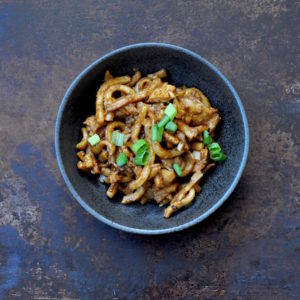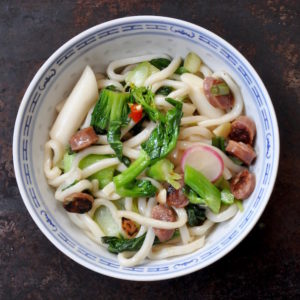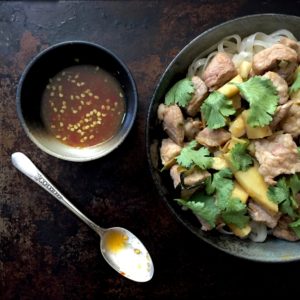Spicy Cold Chinese Noodles
More properly referred to as Spicy And Numbing Cold Noodles, Spicy Chinese Noodles hail China’s Sichuan Province, a place known for hot, muggy summers and the ingestion of chile-laden foods to counter said wet heat.

I’ve prepared Spicy Cold Chinese Noodles with corn, wax beans, red peppers, chile peppers, fresh peas, frozen peas, radishes, scallions, and a shredded chicken thigh.
Read: this dish is easily customized.

Go to an Asian market and prepare to spend hours staring at the vast noodle selection. What works best in this dish? Carolyn Phillips, in her wonderful All Under Heaven, suggests fresh hot water egg noodles, cold water egg noodles, or store-bought wheat noodles. Fuchsia Dunlop, in Every Grain of Rice, uses dried buckwheat noodles. I used Japanese buckwheat noodles…because they’d been sitting in my pantry since 2016. Happily, they were utterly delicious and I felt no need to experiment further.

About that sauce. Yes, it calls for Chinkiang Vinegar, but Carolyn Phillips uses widely available black vinegar in her recipe, so the choice is yours.

Classic Spicy And Numbing Noodle recipes usually have set amounts for sauces. I prefer to taste as I go, meaning the sauce is slightly different each time I make it. Barring dumping entire bottles of soy into the noodles, it’s hard to go wrong here.
Add some shredded chicken or tofu to your Spicy Cold Chinese Noodles, or eat them with just the vegetables. Either way, the noodles keep nicely for few days in the fridge, making it a great lunch or dinner option it’s too hot to think, much less cook.

Spicy Cold Chinese Noodles
Adapted from recipes in Fuchsia Dunlop’s Every Grain of Rice and Carolyn Phillips’s All Under Heaven
Serves: 2-4 people, depending on what else is served.
Preparation time: 15-20 minutes
6-10 ounces/170-280 grams dried buckwheat noodles
approximately 3 ounces/85 grams bean sprouts (optional but tasty)
if you aren’t serving noodles immediately, have a tablespoon or so of peanut or other tasteless oil to prevent the noodles from sticking together
For the vegetables (some suggestions):
1 garlic clove, peeled and minced
1-2 scallions, peeled and sliced into rings
1 small hot chili pepper, seeded or not, minced
1 fresh red pepper, roasted, peeled, and seeded, then cut into strips
1 carrot, peeled and cut into batons or julienne
a handful of green or yellow beans, trimmed and sliced into pieces, raw if very fresh, blanched if desired
1-2 washed julienned radishes
a handful of fresh or frozen peas, lightly cooked
kernels from an ear of fresh corn
Any crisp, fresh vegetables
1-2 cooked chicken breasts or thighs, shredded, or some firm tofu, cut into small pieces
For the sauce:
2 tablespoons Chinkiang vinegar (Black vinegar may be substituted)
3-4 tablespoons chili oil
1 tablespoon light soy sauce (not low salt; regular soy sauce may be used)
1 tablespoon sesame oil, ideally toasted sesame oil
1 scant tablespoon tahini
I teaspoon Sichuan peppercorns (See notes)
a few drops dark soy sauce, to taste, optional
pinch of sugar
Place the bean sprouts in a small pan. Just cover with cold water. Bring to a gentle boil and cook briefly–don’t allow sprouts to become soft or limp. Drain quickly and run under cold tap. Pat dry with paper towels or a clean cloth. Set aside.
Prepare the noodles according to package instructions. If you are planning to eat them cold, once they are drained, run them under the cold tap, then place them in a large bowl. Add the bean sprouts.
If not serving noodles immediately, stir in the peanut oil with a fork or large spoon to distribute.
Prepare the vegetables: trim, peel, and blanch as necessary. Add prepared vegetables to the noodles and either stir or mix with clean hands (my preferred method.)
Make the sauce:
In a medium bowl, stir together the Chinkiang vinegar, chili oil, soy sauce, sesame oil, tahini, and Sichuan peppercorns. Taste. You may want to add that pinch of sugar, more soy sauce, or more chili oil. You may also want to add more tahini (My husband is not fan, so I keep it scant.). Keep stirring and tasting until sauce is to your taste; it should be quite spicy and punchy.
Once the sauce tastes right to you, add it to the noodles. Stir vigorously.
You can add 1-2 cooked, shredded chicken thighs or breasts or firm tofu, or leave proteins out. Serve immediately, or cover noodles and refrigerate until serving time.
Spicy Cold Chinese Noodles keep, covered and refrigerated, up to four days. Do not freeze.
Notes:
You can toss the Sichuan peppercorns into the noodles whole, but they taste best if toasted briefly in a small saucepan over low heat, then crushed in a mortar or spice grinder. Sichuan peppercorns are available online or in markets. They are sometimes sold as “Szechuan” peppercorns.
Cooking water from blanching and noodle making may be saved and used again. Instead of setting the colander in the sink, I place it in a large bowl, catching water from blanching the mung beans, cooking the noodles, and rinsing both. I use this water for dishwashing and plant watering.
I realize my behavior may sound quite peculiar to some readers. California has suffered repeated droughts and is currently battling horrific wildfires. Every bit helps.

Normally I have “empty plate” photographs to conclude posts. Evidently I forgot to take one. Never mind. This is Lake Merritt, in Oakland, California, recently made infamous for all the wrong reasons by one racist fool. Lake Merritt is actually a beautiful spot where people of all nationalities, races, and inclinations mix happily and harmoniously. John and I lived within walking distance for eight years. This shot was taken last weekend while visiting a friend whose apartment has this stupendous view.




